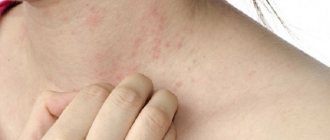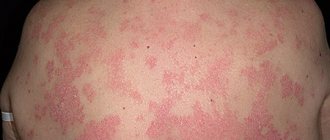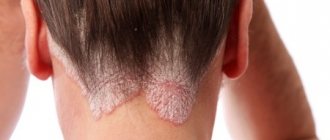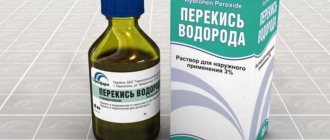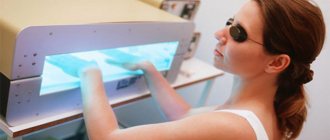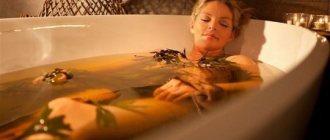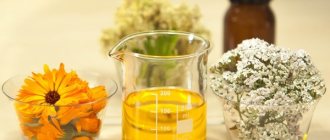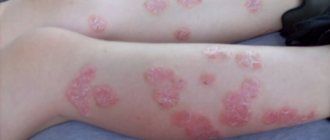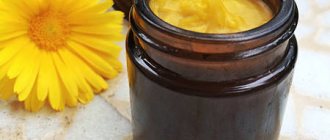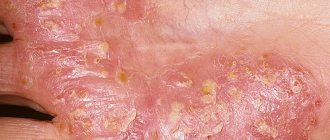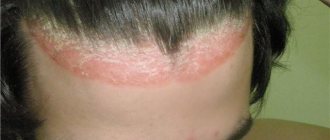Treatment of psoriasis with baths in a hydropathic clinic and at home
In the complex therapy of psoriasis, doctors use not only medications (ointments, creams, tablets), but also various physical procedures, among which baths with various additives are especially popular. The disease cannot be completely cured, but with such means it is possible to significantly alleviate its course and ensure long-term remission, which has a beneficial effect on the quality of life of patients.
Therapeutic baths
Water procedures are useful for pathology, but their incorrect administration has a negative effect on the skin and provokes complications of the disease. For this reason, it is necessary to coordinate bath therapy with the supervising specialist.
Treatment procedures are effective during regression of the disease and during remission:
- improve skin condition;
- eliminate itching, burning and other unpleasant symptoms of psoriasis;
- strengthen the nervous system;
- remove toxins through the pores.
Contraindications and restrictions
There are conditions under which a patient should not take baths:
- cardiovascular pathologies;
- malignant oncological formations on the skin;
- inflammatory processes in the body;
- tuberculosis;
- atherosclerosis;
- diabetes;
- liver and kidney diseases;
- fungal infections, infections;
- epilepsy;
- pregnancy;
- serious condition of the patient.
During periods of exacerbation of psoriasis or rapid progression, baths can lead to complications. If the process of the appearance of lesions on the surface spreads quickly, it is better not to carry out such activities with aggressively working compounds.
During deterioration, the doctor may prescribe corn, oatmeal, tar or starch baths.
With erythroderma, all types of baths are contraindicated.
Contraindications
When prescribing baths, the doctor takes into account the patient’s age, the general condition of the body, the stage of the pathology, and the frequency of exacerbations. The size of psoriatic plaques and localization features on the body are taken into account. There are a number of contraindications that prohibit the treatment of psoriasis with water procedures. These include:
- oncological skin lesions;
- problems with the cardiovascular system;
- infectious diseases;
- tuberculosis in any form;
- renal or liver failure;
- pregnancy.
An absolute contraindication for herbal bath therapy is the complication of psoriasis by erythroderma.
Rules for using baths
The procedures will be effective if applied correctly. To do this, it is recommended to follow certain tips:
- the water temperature should not exceed 37-38 degrees;
- before the procedure, it is necessary to take a shower to remove dead scales and effectively treat the affected areas;
- It is prohibited to use a hard washcloth while bathing;
- after eating, at least 1.5-2 hours should pass;
- the duration of 1 procedure is 25-30 minutes, the number of sessions and the intervals between them depend on the prescribed course and the composition of the bath;
- After the procedure, it is advisable to treat the skin with ointment or cream.
Treatment of psoriasis at home with sea salt - recipes
You can treat psoriasis correctly with salt by following a number of simple rules.
- It is advisable to carry out the procedure before bedtime, as it has a relaxing effect on the body.
- The concentration of natural medicine should not exceed 50 grams per liter of water, the bath should be taken for no more than 20 minutes and the water temperature should not exceed 38 degrees.
- The course of treatment usually includes 15 procedures.
The benefits of sea salt baths - how to take them correctly
Baths with sea salt for psoriasis have a beneficial effect on the condition of the skin. At the same time, the person is spared the side effects of drug treatment such as decreased immunity and allergic reactions.
The first results usually appear after several procedures. The redness of the skin is sharply reduced, and the foci of the disease - plaques - are gradually eliminated. In addition, baths have a pleasant, tonic effect.
For maximum effectiveness, before adding the substance to a ready-made bath, it should be diluted in hot water, wait until the crystals are completely dissolved, and only then pour the solution into the bath. After completing the procedure, you should rinse with warm water.
How to treat nail psoriasis with sea salt
For nail psoriasis, it is recommended to take baths with sea salt and a few drops of lemon juice or iodine.
The procedure lasts about ten minutes, after which you need to rinse your hands with warm water. It is recommended to perform the operation every 2-3 days.
Sea salt for psoriasis on the head
Treatment of the scalp for psoriasis involves taking baths, applying lotions or rubbing the substance directly into the skin.
You should be very careful with the latter method: this type of procedure can be painful, so if rubbing causes physical pain, you should limit yourself to lotions.
The crystals are diluted in hot water, the solution is cooled to a temperature no higher than 38 degrees, soaked in gauze or a cotton towel, wrapped around the head and kept in the lotion for about 10-15 minutes.
Types of components
Sea and kitchen salt
The procedures tone the body, eliminate fatigue, discomfort and irritation, stabilize the nervous system, sleep, normalize blood circulation and promote healing and restoration of the epithelium.
With regular use, there is a reduction in areas of psoriasis, healing of lesions and improvement in general condition.
For the bath, sea or regular table salt without additives is used, but the former has the best healing properties, since it additionally contains useful vitamins and minerals.
Disinfects and softens the skin, reduces itching, reduces inflammation, swelling of tissues, removes toxins and stops the further development of the disease.
The full treatment course is 2 weeks, during which baths with soda are taken every other day. After 3-4 procedures, patients note the disappearance of painful itching and increased peeling, which indicates the activation of the healing process and restoration of the epidermis.
To moisturize and eliminate the feeling of tightness and dryness, the skin after a bath is washed in the shower and lubricated with heated olive oil.
Radon
Improves the condition of the skin and reduces the intensity of inflammation, normalizes metabolism and accelerates the restoration of damaged tissues. Radon also has a beneficial effect on the circulatory system.
For psoriasis, take baths at a temperature of 35-36 degrees for 10 minutes. Add 100 milliliters of radon concentrate to 200 liters of water.
Treatment duration is 10-15 procedures. Repeated therapy is possible after 6 months, sometimes 1 year.
Turpentine
Has an antiseptic and antibacterial effect. For psoriasis, only purified turpentine oil (turpentine) is used. The product irritates the genital mucosa, so before the procedure you need to lubricate these areas with thick baby cream or Vaseline.
Begin treatment with a small dose of oil. The duration of one session is 15 minutes. After completion, they do not dry themselves, but throw on a terry robe or blanket and drink hot tea with raspberries, linden, rose hips or other diaphoretic herbs. After sweating, the patient takes off his robe and takes a warm shower, then wipes himself and lubricates the skin with a rich cream.
The procedures are performed every other day for a month. If necessary, the course of therapy is repeated after 2 weeks.
Hydrogen sulfide
It has a pronounced absorbable and anti-inflammatory effect, accelerates regeneration processes, strengthens the immune system, stabilizes the functioning of the nervous system, and normalizes blood circulation.
The concentration of hydrogen sulfide is selected depending on the severity of the pathological process on the skin. The procedures are carried out within 1 month every 2-3 days. After six months, treatment can be repeated.
Magnesia
Baths with magnesium sulfate powder already in 1 session have a noticeable therapeutic effect on the skin. Epsom salt (magnesia) calms the nervous system, cleanses the skin and relieves unpleasant symptoms of pathology - itching, bleeding, burning, swelling.
The treatment procedure can be carried out once a month to prevent dehydration. After the session you should drink plenty of liquid.
For one bath, 500 grams of magnesia are diluted in hot water. The duration of the appointment is 15 minutes. At the end of the procedure, the patient puts on a warm robe and drinks tea to sweat well, thereby accelerating the removal of waste and toxins from the body. After this, you need to rinse under a warm shower and lubricate the skin with a neutral cream or oil.
Salt baths
Sea salt baths for psoriasis are an excellent inexpensive method that improves the course of the disease. The main advantages of this therapy:
- salt has a keratolytic effect, which accelerates the resolution of plaques;
- the exfoliating effect is visible after the first procedure;
- easy availability of ingredients - bath salts can be bought at any large store;
- low degree of allergies;
- When taking morning baths with salt for psoriasis, the procedure has a tonic effect on a person.
The downside of salt procedures is the possibility of increased itching, especially during the first procedures. Together with tap water, especially with increased hardness, dry skin increases significantly. If there is bleeding from psoriatic plaques after removing hyperkeratotic masses (“scaly”), the irritating effect of salt with unpleasant pain syndrome is possible.
Salt baths for psoriasis at home are very easy to prepare. The ratio of sodium chloride and water is 1:50. The standard procedure, so that the liquid completely covers the body, takes no more than 2.5 kg of salt. You cannot pour it all into prepared water. It must first be dissolved in hot water, at least 65 degrees. Then add this small volume along with salt into the prepared bath, stirring thoroughly.
The duration of the procedure is from 15 minutes. Frequency: at least twice a week. With regular use, salt baths for psoriasis already after 6 sessions give a pronounced positive result. They have no special contraindications; only general restrictions apply. Sea salt is low-allergenic, so even if you are intolerant to herbal baths, it can be used without fear.
At home
Some procedures can be performed not only in medical institutions, but also at home. It is allowed to use baths:
- Salt - pour 1 kilogram of salt into a small volume of hot water, stir and add to the prepared bath.
- Soda - for a regular 200 liter bath you will need 1 package of soda with a volume of 250 grams. The powder is dissolved in a small amount of warm water, and the resulting mixture is poured into the bath.
- Coniferous – 100 milliliters of natural pine needle extract are dissolved in 250 milliliters of hot water and added to the bath.
- Herbal with sage, chamomile, string, celandine - 100 grams of plant material is poured into 1 liter of cool water and boiled over low heat for about 60 minutes. The resulting decoction is infused for 24 hours, then filtered and taken in a bath.
- Starch - reduce itching, soften and soothe the skin. 500 grams of starch are dissolved in cold water (200 milliliters) and poured into the bath. The procedure can last up to 20 minutes. The course of therapy lasts 14 days, sessions are carried out every other day.
- Mustard seeds - normalize blood circulation and have an antiseptic effect. The dry powder is dissolved in 250 milliliters of warm water to the consistency of liquid sour cream and added to the bath. The duration of the session is 15-20 minutes, after which patients take a shower and wrap themselves in a robe or blanket for 1 hour.
- Oatmeal – relieve inflammation, relieve itching, reduce psoriatic formations. To prepare a bath, pour oatmeal with water and boil. Add a little olive oil to the cooled porridge and pour the resulting mass into the bath.
Methods of application
For patients with psoriasis, several recipes have been developed to combat the disease using sea salt. They all have varying degrees of impact on the skin, so it's worth getting a dermatologist's approval before using any recipe.
Baths
It is best to take baths when plaques are spread throughout the body. You need to prepare it like this:
- Take 1-1.5 kg of unrefined salt, pour it into a small container, and then dilute it with hot water.
- While the salt is dissolving, you should fill the bath with water at a temperature of no more than 50 degrees. Remember that hot water causes an exacerbation of psoriasis, so you need to maintain a balance and add cold liquid in time.
- Next, pour the solution into water and take a bath. The optimal duration is 15-20 minutes; you should not sit in it longer.
After 2-3 procedures, the above actions should be supplemented with a massage or rubbing with a soft sponge - this will cleanse the skin of dead cells. Movements should be circular, non-traumatic, any detergents and washcloths are prohibited.
If the skin is very tight after salt, then you can take a shower; in other cases, it is better not to wash off the mineral, but simply pat the skin lightly with a towel. To avoid the feeling of tightness, you can add some moisturizing oils to the water. And if the disease manifests itself against a background of stress or anxiety, it is worth adding a little solution of valerian, chamomile decoction or pine needles.
The course of baths should last for 3 months, they should be taken every 2-3 days. In addition, if a person is bothered by nail psoriasis, it is worth doing local baths. You need to add a little iodine or lemon juice to 1 liter of warm water, as well as 2 tbsp. l. salt. The procedure is carried out with normal frequency, i.e. every 2-3 days for 3 months.
Irrigation
This method is more suitable as a form of prevention, since during an exacerbation it will not help much in recovery - the concentration of the mineral in the liquid is too low. But irrigation can be done 2 times a day, which means that the risk of disease is still reduced.
You need to find an empty spray bottle. Next, prepare the solution: add 3 tbsp to 0.4-0.5 liters of boiled water. l. salt and stir until dissolved. Pour the resulting mixture into a container and simply carry it with you, spraying it periodically on the skin. If the time of exacerbation approaches (autumn, winter), then you can add more salt, thus making the liquid more concentrated. After 3 months of daily procedures, you should take a break.
What baths can you take for psoriasis at home?
People experiencing psoriasis require complex therapy aimed at eliminating both internal and external triggering factors. In addition to taking medications, restoring a normal psycho-emotional state and controlling nutrition, for psoriasis
have an excellent effect They help fight flaking of the skin and ensure the penetration of beneficial microelements into the body. A significant advantage of water procedures is the ability to carry them out at home, but the patient must first consult a doctor. The fact is that this method of treatment has a number of contraindications, namely:
- oncological diseases;
- infection of the skin by pathogenic microorganisms;
- infectious lesion of the epidermis;
- severe forms of cardiovascular diseases (hypertension, angina, atherosclerosis, heart failure, etc.);
- diagnosed epilepsy;
- pregnancy (starting from the middle of the second trimester).
The benefits of sea salt
Sea water has long been known for its therapeutic properties in the treatment of not only various forms of dermatoses, but also for diseases of the respiratory system, heart, blood vessels and the normalization of metabolic processes. Back in Ancient Greece and Rome, healers used the healing properties of sea salt to treat skin diseases. In addition to the healing effect, warm sea water helps to relax, regenerate the skin and stimulate its metabolic processes.
Sea salt itself is produced by evaporation from seawater and is considered an unprocessed natural product. Table salt, in turn, goes through several stages of purification. Therefore, it is sea salt that contains a large amount of natural minerals, the percentage of which, as well as its color, depends on the area of extraction.
Any sea salt contains components that have therapeutic properties:
- Bromine has a calming effect on the nervous system;
- Iodine disinfects and helps fight inflammation;
- Potassium nourishes cells with useful microelements;
- Calcium improves blood clotting and cleanses pores;
- Magnesium relaxes muscle tissue and dissolves subcutaneous fat.
How to take a bath with psoriasis: general recommendations
Good treatment results can only be achieved if certain conditions are met:
- Only containers with a tiled or enamel surface are suitable for the procedure.
- The volume of water is calculated taking into account the size of the affected area - ten liters will be enough for the legs, and up to 250 liters to fill a full bath (depending on the design and proportions of the patient’s body).
- The water temperature should not be too hot.
- When bathing, do not use products that can cause skin irritation - neutral soap and special hypoallergenic shampoos are best. Also, you should not try to forcibly remove dead skin particles or stretch the skin.
- Regardless of what kind of bath you take at home for psoriasis, you should maintain a relaxed body position. For convenience, you can use a roller or towel under your head.
- To achieve the best therapeutic effect and restore normal well-being after finishing bathing, it is recommended to rest for 30 minutes or an hour in a sitting position (on a chair or on a couch).
Considering the increased sensitivity of the skin to external irritants, it makes sense for patients with such diagnoses to completely eliminate contact with chemically aggressive environments, that is, when cleaning, wear gloves and use mainly natural products in everyday life.
How to prepare and take a salt bath
Before taking salt baths for psoriasis, you should purchase a suitable product. It is best to buy unrefined sea salt; it can be found at pharmacies or large cosmetic stores. Flavored or regular table salt cannot be used for medical procedures.
- 1 kg of sea salt should be diluted in hot water in a separate container and wait until it is completely dissolved.
- Fill the bathroom with hot (up to 45°) water and pour the prepared solution into it.
- You should take a salt bath for psoriasis for no more than 20 minutes. If necessary, you can add hot water to it.
- Starting from the 2nd procedure, you should carefully wipe the areas affected by psoriatic plaques with a soft sponge, as well as lightly massage the skin.
- After the session, it is advisable not to wash yourself with water - just lightly pat your skin with a towel. If the covers are too tight, you can take a shower.
What baths should I take for psoriasis to cure it?
To be sure that home therapy will help improve the condition of the skin, dried plants and medicines necessary for water procedures should be purchased at pharmacies. The following types of baths bring the greatest benefit to the body with psoriasis:
- From sage - have antibacterial and anti-inflammatory effects, and are also characterized by astringent properties. To prepare them, you need a liter of water and 100 grams of carefully chopped dry sage.
- From flax seed – provide an enveloping effect and relieve skin itching. They are prepared as follows: pour 250 grams of dry raw materials with five liters of water, boil, filter with gauze and pour into the bathroom.
- Coniferous – suitable for regular therapy and made from natural pine extract (in liquid or briquette form). Particularly effective when affecting the feet and palms.
- Valerian - give stable results, but with prolonged use. To create a medicinal mixture, you can take either a liquid extract of a medicinal plant or a tincture.
- Combined (from pine needles and valerian) - have a positive effect on the skin and improve overall well-being by optimizing lipid metabolism.
Baths for exacerbation of psoriasis
Not all water procedures are contraindicated during the progression of the disease. If there is no erythroderma, but only a red rim around the plaques, then the following types of baths can be used:
- oatmeal;
- tar;
- starch;
- corn.
There is no single method of preparing them, since the effect on the skin during an exacerbation must be carried out in the most gentle manner possible. Oatmeal baths for psoriasis have a pronounced anti-inflammatory effect, promote exfoliation and relieve itching. For water procedures, oatmeal is used. It is dissolved at a ratio of 1:5. The result is a viscous warm substance into which the body is completely immersed for 20 minutes. The frequency of procedures during exacerbation is daily. The course of treatment is up to 7 sessions. Corn and starch baths for psoriasis are prepared in the same way. The thicker the substance, the more pronounced the anti-inflammatory and antipruritic effect.
Tar baths for psoriasis do not have enveloping and healing properties, but give a pronounced anti-inflammatory result. Birch tar should be used with caution as it can cause skin irritation in sensitive people. But thanks to the antiseptic properties of the substances, baths will help with pustular processes that accompany hormonal and cytostatic therapy for psoriasis.
Tar baths are prepared at the rate of 20 ml of the drug per 10 liters of water. Frequency of use – 2 times a week, session duration – 15-17 minutes, duration of the therapeutic course – 7-10 procedures. After the first bath, a slight progression of the disease is possible, which does not require discontinuation of the use of tar. This is a normal reaction due to the irritating effect of the drug.
What baths can you take for psoriasis at home?
People experiencing psoriasis require complex therapy aimed at eliminating both internal and external triggering factors. In addition to taking medications, restoring a normal psycho-emotional state and controlling nutrition, for psoriasis
have an excellent effect They help fight flaking of the skin and ensure the penetration of beneficial microelements into the body. A significant advantage of water procedures is the ability to carry them out at home, but the patient must first consult a doctor. The fact is that this method of treatment has a number of contraindications, namely:
- oncological diseases;
- infection of the skin by pathogenic microorganisms;
- infectious lesion of the epidermis;
- severe forms of cardiovascular diseases (hypertension, angina, atherosclerosis, heart failure, etc.);
- diagnosed epilepsy;
- pregnancy (starting from the middle of the second trimester).
How to take a bath with psoriasis: general recommendations
Good treatment results can only be achieved if certain conditions are met:
- Only containers with a tiled or enamel surface are suitable for the procedure.
- The volume of water is calculated taking into account the size of the affected area - ten liters will be enough for the legs, and up to 250 liters to fill a full bath (depending on the design and proportions of the patient’s body).
- The water temperature should not be too hot.
- When bathing, do not use products that can cause skin irritation - neutral soap and special hypoallergenic shampoos are best. Also, you should not try to forcibly remove dead skin particles or stretch the skin.
- Regardless of what kind of bath you take at home for psoriasis, you should maintain a relaxed body position. For convenience, you can use a roller or towel under your head.
- To achieve the best therapeutic effect and restore normal well-being after finishing bathing, it is recommended to rest for 30 minutes or an hour in a sitting position (on a chair or on a couch).
Considering the increased sensitivity of the skin to external irritants, it makes sense for patients with such diagnoses to completely eliminate contact with chemically aggressive environments, that is, when cleaning, wear gloves and use mainly natural products in everyday life.
How to take a medicinal bath correctly
In order for the therapy to have an effect, you need to know how to treat psoriasis correctly, how much product to add and how long to carry out the procedure.
DOCTORS RECOMMEND:
In order to get rid of psoriasis and restore the original health of the skin, use a proven method: apply a simple product for 7 days in a row...
more details >
Baths with sea salt for psoriasis should not be made very hot. The temperature may be a couple of degrees higher than body temperature. If the water has cooled, you need to add hot water. The duration of the procedure is 15-20 minutes. All areas where plaques are localized should be immersed in water.
It is not recommended to use a towel - if the water dries itself, then sea salt for psoriasis will act more effectively and longer.
You cannot use any cosmetics. Repeat the procedure 3 times a week for 3 weeks, and if necessary, longer.
You may be interested in: The most popular herbs for psoriasis: how to recover faster?
It is necessary to massage the affected areas with a soft sponge to remove the stratum corneum. However, this should be done carefully, since this manipulation is not suitable for everyone. It should be carried out only if it does not provoke any irritation.
You can introduce additional components: iodine (you only need to add a couple of drops), it will enhance the antiseptic effect; pine extract to reduce peeling and stimulate regenerative processes; valerian extract for a relaxing effect.
You can prepare a solution with soda and salt by dissolving 0.5 kg of each product in water.
The effect is noticeable almost immediately after the procedure: skin redness disappears, it becomes softer. Psoriatic plaques also soften and the skin stops peeling. This action lasts about 4 days.
Rules for preparing baths
There are many popular resorts, but it is not always possible to visit them. To get a good effect when preparing a bath for psoriasis at home, you must adhere to the following recommendations:
- the bathtub is filled with water, but very hot water should not be used, as this can aggravate the manifestations of psoriasis;
- 1 kg of sea salt is diluted in 2 liters of water (boiled, temperature 50 degrees);
- After the salt has dissolved, the water is poured into the bath.
Recipes
To prepare a compress, use the following recipes:
- Salt compresses. Add 100 grams of salt to 1 liter of water and stir. Gauze folded in 8 layers is immersed in the resulting solution. After soaking, wring out the gauze and cover the flaky area with it. The top of the compress must be wrapped in cling film and wrapped. It is recommended to carry out the procedure before bedtime, and do not remove the compress until the morning.
- Salt dressings are made in the same way. They can be used on any area where the spots are located, including lesions on the head. Natural fabric is dipped into a solution prepared in a ratio of 1:10, wrung out and applied for 8 hours.
- There is another recipe: add 2 tbsp to 1 liter of hot water. salt. The fabric is dipped into the prepared solution, wrung out and applied hot to the painful area for 30 minutes.
- You can use a dry compress. Salt is heated in a frying pan to 70 degrees, poured into a bag made of natural fabric and kept on the inflamed areas for 40 minutes. If the temperature is very high and applying the compress is painful, wax paper can be placed between the bag and the skin.
- To alleviate the condition when psoriasis occurs on the scalp, finely ground salt is used. After regular washing with water, rub it into the skin and keep it for 30-40 minutes, after which it is washed off with warm water.
What baths should I take for psoriasis to cure it?
To be sure that home therapy will help improve the condition of the skin, dried plants and medicines necessary for water procedures should be purchased at pharmacies. The following types of baths bring the greatest benefit to the body with psoriasis:
- From sage - have antibacterial and anti-inflammatory effects, and are also characterized by astringent properties. To prepare them, you need a liter of water and 100 grams of carefully chopped dry sage.
- From flax seed – provide an enveloping effect and relieve skin itching. They are prepared as follows: pour 250 grams of dry raw materials with five liters of water, boil, filter with gauze and pour into the bathroom.
- Coniferous – suitable for regular therapy and made from natural pine extract (in liquid or briquette form). Particularly effective when affecting the feet and palms.
- Valerian - give stable results, but with prolonged use. To create a medicinal mixture, you can take either a liquid extract of a medicinal plant or a tincture.
- Combined (from pine needles and valerian) - have a positive effect on the skin and improve overall well-being by optimizing lipid metabolism.
Consulting a doctor will help you understand which baths are best to take for psoriasis in your particular case. Naturally, if you are allergic to any herbal components, you should avoid using them in the process of home treatment.
One of the effective methods of combating the external signs of psoriasis can be considered external use and baths with the addition of various.
Effective baths for psoriasis: indications and rules of use
Psoriasis cannot be completely cured, as it is a chronic disease characterized by phases of remission and exacerbation. Psoriatic plaques can cover large areas of the human body if left untreated or if ineffective treatments are used. They cause very great discomfort, as they itch, peel, leaving a lot of scales; scratched areas can bleed and become complicated by deeper lesions.
Baths for psoriasis: how to take them correctly
The purpose of medicinal baths is a therapeutic effect, which is achieved by exposing the skin to healing substances added to the water. Therefore, before taking a bath for psoriasis, you should wash your body in the shower, using neutral-based gel or soap.
Thus, dirt and dead skin particles will be washed away, which will allow the active substances of the solution to penetrate deeper and faster into the layers of the epidermis and have a stronger effect.
General recommendations for taking baths for medicinal purposes are as follows:
- The procedure should not be carried out earlier than 60 minutes after eating.
- The water in the container should be at a temperature of 37-38 o C. If it is lower, it will cause a feeling of discomfort, and if it is higher, the heart will receive additional stress.
- Procedures lasting more than 20 minutes have contraindications for psoriasis. During this time, the substances will be completely absorbed into the skin, and with a longer stay, the skin can lose a lot of natural fat, without which it will be dry.
- After the bath, apply cosmetic oil or neutral cream to the skin. You can use baby skin care products for this.
- Such procedures cannot be done daily. Optimal frequency is 2-3 times a week.
Before using the procedures, you should consult with your doctor, because certain active healing substances added to the water may have side effects or cause allergies.
How to take a bath correctly
In order for this procedure to bring maximum benefit at home, the following requirements must be taken into account:
- The water temperature should be 37-38 degrees Celsius. If the water is colder, the result will not be very good, and if it is higher, then the water will already be hot and will have a negative effect on irritated skin; besides, hot baths increase the load on the heart.
- A special bath is not considered a means of bathing, since it is aimed at treatment, so before a therapeutic bath, it is better to take a shower and wash off daily impurities with soap.
- The duration of bathing should not exceed more than 20 minutes, since the skin will lose more fatty tissue, which it needs to protect the top layer from the negative effects of the environment.
- The treatment session should be an hour before a meal, or an hour after a meal, since a treatment session immediately after a meal can cause vomiting because the food is not digested.
- The optimal period of sessions is 2-3 times a week.
- After the procedure, apply any moisturizer.
- Do not drink alcohol or smoke before the session.
- Increase the volume of fluid consumed. Be sure to drink herbal teas to treat psoriasis and also improve immunity.
The following diseases are considered contraindications:
- Tumors
- Tuberculosis
- Hypertension
- Diabetes
- Pregnancy, especially after 20 weeks
- Cardiovascular diseases
Taking into account these simple requirements, the treatment session will bring good results after just two weeks of regular bathing.
Baths for psoriasis: contraindications
Baths for psoriasis at home cannot be taken by everyone and not always. There are a number of contraindications for this procedure. These are diseases:
- of cardio-vascular system;
- hypertension;
- diabetes;
- epilepsy;
- atherosclerosis;
- tuberculosis;
- malignant tumors.
This method should also not be used by pregnant women in the second trimester or people with skin affected by fungus or infection.
Contraindications for psoriasis relate to medicinal baths with the addition of medicinal herbs or other active substances. The doctor, taking into account the characteristics of your body, will give advice on whether you should take such baths.
Main rules when using baths
Bathing for people with psoriasis improves their condition. You should not take a bath for too long. Benefits are obtained from salt, herbal decoctions, turpentine, oatmeal, which softens the skin. No allergic reaction? Any session turns out to be healing.
Let's consider the rules that are considered general health benefits:
- Optimal water temperature is +33 °C to +37.5 °C. The above is prohibited.
- Before the bathroom, the client takes a shower, washes with gel and soap.
- The patient eats breakfast, lunch, dinner on his own, walks for 1.5 hours, and completes his plans.
- 1 session lasts as long as the doctor advises, maximum 30 minutes.
- When carrying out activities, doctors recommend eating normally (without low-calorie diets). Before you start, you need to eat. Empty stomach? Swimming is contraindicated.
- Optimally, get 3 sessions (7 days).
- Water dries out the skin. When the appointment is over, the doctors suggest lubricating the skin with a rich baby cream.
Is the water too hot? Cardiac load increases. Young people, middle aged? The water is made warmer. Over 35 years old? Cooler. Man, woman 55 years old? Baths for psoriasis at home are poured at +32-33 °C.
On the advice of the doctor, young people swim at +40 °C. Most young people have a normal metabolism, and some are overweight. The client takes a hot bath for only 20 minutes, not a maximum of 30 minutes.
It is optimal to wash in the shower with a gel that thoroughly cleanses the skin. A washcloth that irritates psoriatic growths is prohibited. Doctors say that sessions against the disease are optimally carried out after 1-2 days. 1 will end, many take a break of 2-3 days, then 2 will be carried out.
Does the individual tolerate treatment easily? The latter is administered daily. The skin becomes very dry. After finishing, the body is lubricated with rich cream.
About contraindications
Baths against psoriasis have contraindications. The treating specialist will immediately announce:
- tumors;
- heart failure;
- severe angina;
- tuberculosis;
- high pressure;
- epilepsy;
- The woman is pregnant and has been carrying the baby for more than 4 months.
Salt baths for psoriasis
Salt baths for psoriasis have a pronounced therapeutic effect when the procedures are repeated regularly:
- the general condition of the skin improves;
- damage heals faster;
- the area affected by psoriatic plaques decreases.
Especially, baths with sea salt for psoriasis help improve the condition of scaly formations on the palms and soles, providing an anti-inflammatory, antiseptic effect and eliminating itching.
They also help improve overall health:
- normalize the functioning of the nervous system, relieve insomnia;
- improve blood circulation;
- activate wound healing and tissue restoration;
- eliminate irritability and fatigue;
- have a tonic effect on the body;
- relieve discomfort.
Sodium chloride baths are very popular in sanatorium-resort institutions. A similar effect is also achieved when swimming in the sea. But a salt bath at home will be no less effective.
It does not have to be taken with sea salt. For this purpose, an ordinary kitchen one that does not have any impurities may be suitable. You will need 1 kg of it to carry out the treatment procedure. The salt is first dissolved in a bowl of hot water and then added to the bath.
But still, sea salt has the best effect for psoriasis, because it is a rich source of beneficial minerals. It can be purchased at pharmacies or other points of sale.
You should take a shower after water-salt therapy, as skin irritation may occur from remaining microparticles.
Sea salt baths
Despite its high prevalence, and, according to statistics, every fourth person on the planet suffers from psoriasis, scientists and doctors continue to research the causes and origins of this disease. The only indisputable cause of psoriasis, which all medical luminaries agree with, is impaired metabolism, and therefore all treatment methods offered by modern medicine are aimed at normalizing metabolic processes in the body.
Analysis of numerous materials devoted to the study of this disease leads to clear conclusions: psoriasis is a disease that requires an individual therapeutic approach. Medicines that are effective for one person are completely useless for another, and each sufferer of this disease often has to try many remedies before finding one that can resist the disease. It is not surprising that the doctor’s diagnosis of psoriasis sounds frightening to the patient.
One of the effective ways to use sea salt for medicinal purposes is a bath. A bath with sea salt, even without additional additives, can soothe the skin and relieve painful itching. After just a few salt baths, the patient feels significant relief. In addition, therapeutic baths for psoriasis guarantee the complete absence of side effects that inevitably accompany the medicinal effects of chemicals.
A sea salt bath is an absolutely affordable treatment because... does not require special conditions, special devices or significant financial costs. It can be easily used at home. All you need to do is visit the pharmacy, buy a packet of sea salt and prepare a bath. For those who cannot afford seaside healing resorts, such baths are irreplaceable.
Baths for psoriasis: reviews
Judging by the reviews, baths for psoriasis always have a positive effect if used correctly. Patients note a significant dulling of the severity of symptoms, improvement in skin condition, reduction of affected areas, and disappearance of the rash.
People speak of water-salt procedures as a miraculous method of getting rid of plaques. Those suffering from this disease for about 40 years were able to achieve a significant reduction in the affected areas and long-term remission after 7 years of regular use of salt.
Also, water with the addition of a decoction of oatmeal and medicinal plants, soda and other substances with healing properties has a good effect.
It's up to you to decide which baths to take. But don't forget to consult your doctor.
The benefits of salt baths
Taking baths with the addition of sea salt is an effective addition to the main psoriasis treatment program.
Such procedures may well replace swimming in the sea, since this product has all the beneficial properties of sea water:
- sea salt for psoriasis has an antiseptic effect on the dermis affected by plaques;
- the product has a restorative effect and helps accelerate skin regeneration;
- sea salt increases the speed of metabolic processes in cells;
- the unique properties of the product help eliminate the symptoms that accompany psoriasis - it effectively neutralizes specific itching and burning;
- A course of salt baths helps strengthen local immunity.
The positive effect is achieved due to the unique composition of sea salt: it contains a lot of iodine, zinc and calcium, selenium, sodium and bromine, as well as copper and iron. All these elements accelerate the healing process of the dermis.
Therapeutic procedures help not only to eliminate the unpleasant symptoms of the disease, but also to significantly delay the next episode of psoriatic plaque formation.

